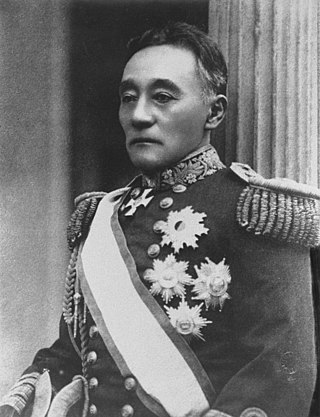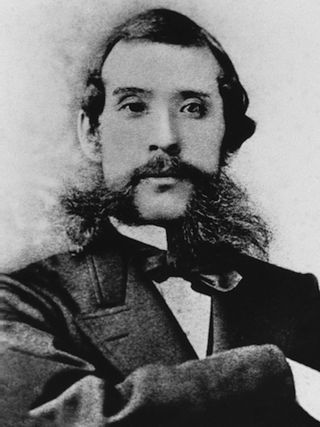
Ōkubo Toshimichi was a Japanese statesman and one of the Three Great Nobles regarded as the main founders of modern Japan.

Saigō Takamori was a Japanese samurai and nobleman. He was one of the most influential samurai in Japanese history and one of the three great nobles who led the Meiji Restoration. Living during the late Edo and early Meiji periods, he later led the Satsuma Rebellion against the Meiji government. Historian Ivan Morris described him as "the quintessential hero of modern Japanese history".

The Boshin War, sometimes known as the Japanese Revolution or Japanese Civil War, was a civil war in Japan fought from 1868 to 1869 between forces of the ruling Tokugawa shogunate and a coalition seeking to seize political power in the name of the Imperial Court.

The Satsuma Rebellion, also known as the Seinan War, was a revolt of disaffected samurai against the new imperial government of the Empire of Japan, nine years into the Meiji era. Its name comes from the Satsuma Domain, which had been influential in the Restoration and became home to unemployed samurai after military reforms rendered their status obsolete. The rebellion lasted from 29 January until 24 September of 1877, when it was decisively crushed, and its leader, Saigō Takamori, was shot and mortally wounded.

The Battle of Shiroyama took place on 24 September 1877, in Kagoshima, Japan. It was the final battle of the Satsuma Rebellion, where the heavily outnumbered samurai under Saigō Takamori made their last stand against Imperial Japanese Army troops under the command of General Yamagata Aritomo and Admiral Kawamura Sumiyoshi. The battle culminated in the annihilation of Saigō and his army, marking the end of the Satsuma Rebellion. The Imperial Army's victory consolidated their power, and the Satsuma Rebellion was the last instance of internal mutiny seen in the Empire of Japan.

Count Kawamura Sumiyoshi, was an admiral in the Imperial Japanese Navy. Kawamura's wife Haru was the aunt of Saigō Takamori.

The Satsuma Domain, briefly known as the Kagoshima Domain, was a domain (han) of the Tokugawa shogunate of Japan during the Edo period from 1600 to 1871.

Saigō Jūdō was a Japanese politician and admiral in the Meiji period.

The Meiji oligarchy was the new ruling class of Meiji period Japan. In Japanese, the Meiji oligarchy is called the domain clique.

The Battle of Hakodate was fought in Japan from December 4, 1868 to June 27, 1869, between the remnants of the Tokugawa shogunate army, consolidated into the armed forces of the rebel Ezo Republic, and the armies of the newly formed Imperial government. It was the last stage of the Boshin War, and occurred around Hakodate in the northern Japanese island of Hokkaidō. In Japanese, it is also known as the Battle of Goryokaku.

The Battle of Toba–Fushimi occurred between pro-Imperial and Tokugawa shogunate forces during the Boshin War in Japan. The battle started on 27 January 1868, when the forces of the shogunate and the allied forces of Chōshū, Satsuma and Tosa Domains clashed near Fushimi, a town near Kyoto, the sacred capital, and fighting progressed to the Toba road leading to Osaka, with the initial rout of the Satsuma from Fushimi. The battle lasted for four days, ending in a decisive defeat for the shogunate.

The Saga Rebellion was an 1874 uprising in Kyūshū against the new Meiji government of Japan. It was led by Etō Shinpei and Shima Yoshitake in their native domain of Hizen.

Baron Yamakawa Hiroshi was a Bakumatsu period Aizu samurai who subsequently became a general in the early Meiji period Imperial Japanese Army, and a noted politician and educator. He was also one of the first persons to write a history of the Aizu War from the Aizu perspective. His brother-in-law was noted general Oyama Iwao, who married his sister Sutematsu.

Kirino Toshiaki was a Japanese samurai of the late Edo period, and an Imperial Japanese Army general of the early Meiji era.

The Siege of Kumamoto Castle from February 19 to April 12, 1877, in Kumamoto, Japan, was a major battle of the Satsuma Rebellion.

Kawaji Toshiyoshi, also known as Kawaji Toshikane, was a Japanese military general, politician, and samurai. during the Meiji period. A Satsuma Domain samurai initially tasked to study foreign systems for application in the Japanese military, Kawaji fought against forces loyal to the Tokugawa shogunate during the Boshin War. Later, his work on setting up the Japanese police at the aftermath of the Meiji Restoration, first as rasotsu, and then as keisatsu, earned him the recognition as the founder of Japan's modern police system. Besides his police and military work, he was also noted for his contributions to the development of Kendo, a Japanese martial art.
The Shizoku was a social class in Japan composed of former samurai after the Meiji Restoration from 1869 to 1947. Shizoku was a distinct class between the kazoku and heimin (commoners) with no special class privileges, and the title was solely on the register. The Shizoku were abolished in the revised civil code in 1947 after the Japanese defeat in World War II.
Events in the year 1877 in Japan.

Battōtai were a special police squad formed in Japan by the Meiji government in 1877 during the Satsuma Rebellion. The detachment was armed with Japanese swords. The members of Battotai defeated the rebels in the Battle of Tabaruzaka. Their success in sword fighting led to a renewed interest in the art of kenjutsu, which had been abandoned after the Meiji restoration, and, as a result, the formation of modern kendo.

The Shi-gakkō or Shigakkō was a system of military academies in Kagoshima Prefecture, Japan during the early Meiji era. Created by Saigō Takamori, the building of these schools and the organization of a political clique inside its walls was a cause of the Satsuma Rebellion. Many officers involved in the rebellion on the side of the Satsuma Domain were graduates of the Shi-gakkō. The main site was located in Shiroyama-chō, Kagoshima, on the site of the current National Hospital Organization Kagoshima Medical Center.


















